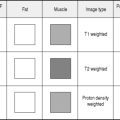Chapter 5 Urinary tract
Methods of imaging the urinary tract
Akin O., Hricak H. Imaging of prostate cancer. Radiol. Clin. North Am.. 2007;45(1):207-222.
Zhang J., Gerst S., Lefkowitz R.A., et al. Imaging of bladder cancer. Radiol. Clin. North Am.. 2007;45(1):183-205.
Zhang J., Lefkowitz R.A., Bach A. Imaging of kidney cancer. Radiol. Clin. North Am.. 2007;45(1):119-147.
Excretion Urography
Also known as intravenous urography (IVU). The technique is much less frequently used than in the past, being largely replaced by CT, MRI or US.
Contraindications
See Chapter 2 – general contraindications to intravenous (i.v.) water-soluble contrast media and ionizing radiation. Pre-medication with steroids (see Chapter 2) may be considered but information regarding the renal size, presence of calcification and pelvicalyceal systems may be gained by using a combination of plain film, US, unenhanced CT and MRI.
Patient preparation
Preliminary film
If necessary, the position of overlying opacities may be further determined by:
Films
ULTRASOUND OF THE URINARY TRACT IN ADULTS
Technique
ULTRASOUND OF THE URINARY TRACT IN CHILDREN
Indications (after Lebowitz, 1985)1
Patient preparation
Full bladder. Patients with an indwelling catheter should have this clamped 1 h before the examination is scheduled.
Technique
Computed Tomography of the Urinary Tract
Indications
Technique
CT urogram
Kluner C., Hein P.A., Gralla O., et al. Does ultra-low-dose CT with a radiation dose equivalent to that of KUB suffice to detect renal and ureteral calculi? J. Comput. Assist. Tomogr.. 2006;30(1):44-50.
Van Der Molen A.J., Cowan N.C., Mueller-Lisse U.G., et alCT Urography Working Group of the European Society of Urogenital Radiology (ESUR). CT urography: definition, indications and techniques. A guideline for clinical practice. Eur. Radiol.. 2008;18(1):4-17.
Magnetic Resonance Imaging of the Urinary Tract
Technique
Technique will be tailored to the clinical question with MR urography used to investigate the renal tract as a whole. MRI of the abdomen and pelvis can be obtained to assess retroperitoneal adenopathy as part of the staging investigations for patients with bladder and prostate cancer, but CT is often used for this purpose with MRI used for local staging.
MAGNETIC RESONANCE UROGRAPHY
The two most common MR urographic techniques are:
Indications
Technique
Leyendecker J.R., Barnes C.E., Zagoria R.J. MR urography: techniques and clinical applications. Radiographics. 2008;28(1):23-46. discussion 4647
Nikken J.J., Krestin G.P. MRI of the kidney – state of the art. Eur. Radiol.. 2007;17(11):2780-2793.
Takahashi N., Kawashima A., Glockner J.F., et al. Small (<2-cm) upper-tract urothelial carcinoma: evaluation with gadolinium-enhanced three-dimensional spoiled gradient-recalled echo MR urography. Radiology. 2008;247(2):451-457.
Magnetic Resonance Imaging of the Bladder
Soulez G., Pasowicz M., Benea G., et al. Renal artery stenosis evaluation: diagnostic performance of gadobenate dimeglumine-enhanced MR angiography – comparison with DSA. Radiology. 2008;247(1):273-285.
Willmann J.K., Wildermuth S., Pfammatter T., et al. Aortoiliac and renal arteries: prospective intraindividual comparison of contrast-enhanced three-dimensional MR angiography and multi-detector row CT angiography. Radiology. 2003;226(3):798-811.
Micturating Cystourethrography
Technique
To demonstrate vesico-ureteric reflux
Aftercare
Complications
Due to the contrast medium
ASCENDING URETHROGRAPHY IN THE MALE
Technique
Retrograde Pyeloureterography
Indications
Technique
In the operating theatre
The surgeon catheterizes the ureter via a cystoscope and advances the ureteric catheter to the desired level. Contrast medium is injected under fluoroscopic control and spot films are exposed.
In the X-ray department
About 2 ml of contrast medium are injected at each of these levels and films taken.
PERCUTANEOUS NEPHROSTOMY
The introduction of a drainage catheter into the collecting system of the kidney.
Technique
Identifying the collecting system
Techniques of puncture, catheterization
PERCUTANEOUS RENAL PUNCTURE AND BIOPSY
Contrast medium
US guidance is generally used for preliminary visualization of the kidneys:
Technique
RENAL CYST PUNCTURE OR BIOPSY
ANTEGRADE PYELOGRAPHY
PERCUTANEOUS NEPHROLITHOTOMY
Equipment
Technique
Methods of opacification of the collecting system
Dilatation
This is carried out under general anaesthesia. It is performed using Teflon dilators from 7-F to 30-F, which are introduced over the guidewire. Alternatively, metal coaxial dilators or a special angioplasty balloon (10 cm long) are used. A sheath is inserted over the largest dilator or balloon through which the nephroscope is passed followed by removal of the calculus or disintegration.
RENAL ARTERIOGRAPHY
INDICATIONS
Contrast medium
STATIC RENAL SCINTIGRAPHY
Images
Additional images
Anterior images may be taken in cases of suspected pelvic or horseshoe kidney and severe scoliosis, or if relative function is to be calculated by geometric mean method.
Analysis
Additional techniques
Blaufox M.D. Procedures of choice in renal nuclear medicine. J. Nucl. Med.. 1991;32:1301-1309.
Cosgriff P.S. The urinary tract. In: Sharp P.F., Gemmell H.G., Murray A.D., editors. Practical Nuclear Medicine. 3rd edn. London: Springer-Verlag; 2005:205-229.
Hilson A.J. Functional renal imaging with nuclear medicine. Abdom. Imaging. 2003;28:176-179.
Dynamic Renal Scintigraphy
Radiopharmaceuticals
Patient preparation
Technique
Additional techniques
1 Woolfson R.G., Neild G.H. The true clinical significance of renography in nephro-urology. Eur. J. Nucl. Med.. 1997;24:557-570.
2 Taylor A., Nally J., Aurell M., et al. Consensus report on ACE inhibitor renography for detecting renovascular hypertension. J. Nucl. Med.. 1996;37:1876-1882.
3 Blaufox M.D., Aurell M., Bubeck B., et al. Report of the Radionuclides in Nephrourology Committee on renal clearance. J. Nucl. Med.. 1996;37:1883-1890.
4 Pickworth F.E., Vivian G.C., Franklin K., et al. 99Tcm-mercapto acetyl triglycine in paediatric renal tract disease. Br. J. Radiol.. 1992;65:21-29.
Blaufox M.D. Procedures of choice in renal nuclear medicine. J. Nucl. Med.. 1991;32:1301-1309.
Cosgriff P.S. The urinary tract. In: Sharp P.F., Gemmell H.G., Murray A.D., editors. Practical Nuclear Medicine. 3rd edn. London: Springer-Verlag; 2005:205-229.
Hilson A.J. Functional renal imaging with nuclear medicine. Abdom. Imaging. 2003;28:176-179.
Direct Radionuclide Micturating Cystography
Technique1
This examination is most frequently performed on children. Direct radionuclide cystography is considered to be at least as sensitive as conventional X-ray micturating cystourethrography (MCU) for the detection of vesicoureteric reflux.1 The examination enables continuous imaging and quantification of bladder, ureter and kidney activity to be performed and delivers a much smaller radiation dose than conventional cystography.
The technique requires catheterization and is similar to that for MCU except that:
Additional techniques
1 Mandell G.A., Eggli D.F., Gilday D.L., et al. Procedure guideline for radionuclide cystography in children. J. Nucl. Med.. 1997;38:1650-1654.
2 Fettich J.J., Kenda R.B. Cyclic direct radionuclide voiding cystography: increasing reliability in detecting vesicoureteral reflux in children. Pediatr. Radiol.. 1992;22:337-338.





